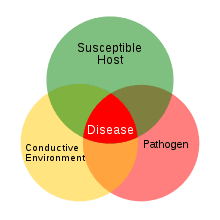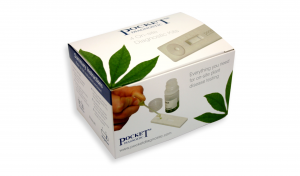In this blog post guest contributor, David Haddad – a South African horticulturist and business owner – delves into the spread of plant disease and how it affects our food supply and livelihoods. You may even be transmitting a plant disease without knowing it!
As with the global COVID-19 pandemic, we saw the ease with which disease spreads from organism to organism, and geographically from country to country. Disease takes hold with precision; prolific spread its only objective. However, with research and technology, we can better understand disease, how to detect it, and how to take action to protect our plants & crops.
Why Now? What’s Different?
Plant diseases need three things to infect and develop:
1) a pathogen or disease-causing organism;
2) a host organism; and
3) favourable environmental conditions.
This is known as the ‘disease triangle’ and will govern the extent to which the disease is able to take over and how much damage will be inflicted.
In the last 50 years, the world has seen a massive population explosion, the creation of a ‘global village’, a changing climate, and a growing consumer demand for exotic plant species. These ingredients make for ideal conditions for the spread of plant diseases and increases our risk of a global plant-health crisis.
Diseases are now able to ‘hitch a ride’ on aeroplane cargo, or on the shoe soles of global travellers, and easily travel half-way across the world where they can make new infections and wreak havoc. Plants imported from foreign countries could carry a microscopic amount of disease, or a tiny pathogenic insect that finds a welcoming new home. In addition, Climate Change is creating the possibility of warmer-climate diseases newly infecting countries experiencing rising temperatures and heat waves. Research has shown the prevalence of fungal diseases, the most common type of plant disease, migrating towards the poles due to the warmer temperatures. So, it’s more important than ever to stop plant disease before outbreaks.
Lives and Livelihoods In Jeopardy
One cannot talk about plant disease without mentioning the Irish Potato Famine (1845-1849) caused by potato ‘late blight’ (Phytophthora infestans) infections on successive years’ crops resulting in large scale crop-losses, famine and significant loss of life.
We’re also hearing about ongoing issues in the forests of Scotland and Wales where new cases of Phytophthora ramorum and P.pluvialis are regularly reported. The UK Forestry Commission has only recently lifted a restriction on the use and movement of timber from areas currently affected by Phytophthora. There is currently no cure for Phytophthora infections; slowing the spread through preventative measures – such as testing and biosecurity countermeasures – or pruning, or complete removal of infected trees is the only option.
The UK agricultural industry was valued at £10.4 billion in 2022 and suffers nearly £200 million worth of crop losses annually due to plant pests & diseases. This equates to almost a million tonnes of crops lost each year.
Persistent threats remain to the UK and European food and forestry industries:
- Phytophthora spp affects commonly grown trees such as Douglas fir, pine tree species, tanoak and larch; commonly grown for timber, as well as tomatoes, beans, uberginea and courgette, pepper, and squash crops.
- Erwinia amylovora (more common in Southern or warmer parts of the UK) infects apple and pear orchards, and thrives in densely planted beds of strawberries or roses. Minor cases of infection have also been reported on peach and apricot trees.
- Ralstonia solanacearum is commonly regarded as the most destructive plant pathogen across the world, affecting potatoes, tomatoes, and peppers. The British Society for Plant Pathology is starting trials to test the effectiveness of a vaccine against the disease but is still years away from viability.
- Potato Virus Y (PVY) can reduce yields by up to 80%. The UK suffers an estimated £18 million worth of damages annually from potato viruses.
The re-emergence of some diseases in the UK, and globally, has been attributed to a globalisation, changing climate, and plant species’ inability to adapt to the rapidly growing list of new environmental threats. This research paper focusses on the effects of climate change on plant pathogens and food security. Monoculture – common agricultural practice of growing a single species of crop in an area – is also a direct factor in the emergence and spread of plant diseases. Ecosystems with genetic diversity prove far more resilient during an outbreak of disease.
On a global scale, around 10% to 16% of food supply is lost to plant pests & diseases annually: 30.3% of rice, 22.6% of maize, and 21.5% of wheat. Environmental experts and plant epidemiologists are warning of the devastating consequences that a global plant-disease pandemic would pose to humans.
Technology is Our Friend
There is no shortage of evidence of the battle we must continue to fight against plant disease and pathogens. For large-scale farmers, urban farming entrepreneurs, allotment gardeners, and the individual starting a veggie patch in their backyard, disease control is your top priority! An effective Integrated Pest Management plan uses a combination of biological controls (natural techniques), chemical controls (pesticide/insecticide/fungicide), technological controls (use of technology such as rapid testing) and cultural controls (education) – favouring biological treatment controls where possible – to tackle the problem. I covered Disease and Pest Management Plans in more detail in my previous blog on urban farming.
The key to effective plant disease management – regardless of the tools and funds available – is speed of addressing issues!
Pocket Diagnostic®’s revolutionary range of lateral flow tests, has given everyone an affordable way to effectively diagnose plant diseases in minutes anywhere, anytime – no training required! A budding urban farmer can diagnose a Ralstonia solanacearum infection on a tomato plant, or an arborist can diagnose a suspected Phytophthora infection on their Radiata Pine trees.
The Pocket Diagnostic® team recently handled a call from a Mexican agriculturist who wanted to purchase 50 of their rapid tests to help minimise plant disease issues they were having with their banana, eggplant and tomato crops. They quickly realised the potential future impact of the issue and orders 500 tests instead, because prevention really is better than cure when it comes to plant pathogens.
Key Takeaway
Early detection is key in preventing the spread of disease and possible devastation of our food security and agricultural industries. Lateral flow technology makes it easy for anyone to diagnose disease in-field on their farm or in their garden, within a couple of minutes. Responsible, measured treatment protocols can then be administered, and in some cases entire harvests or plant species could be saved.
Give a thought to plant disease and its effects next time you shop for groceries, purchase a piece of furniture, or take a trip on an aeroplane. Our generation once thought a global pandemic was not possible, until 2020 and our lives changed forever. The same could happen in our plant kingdom, but with much dire consequences for us.